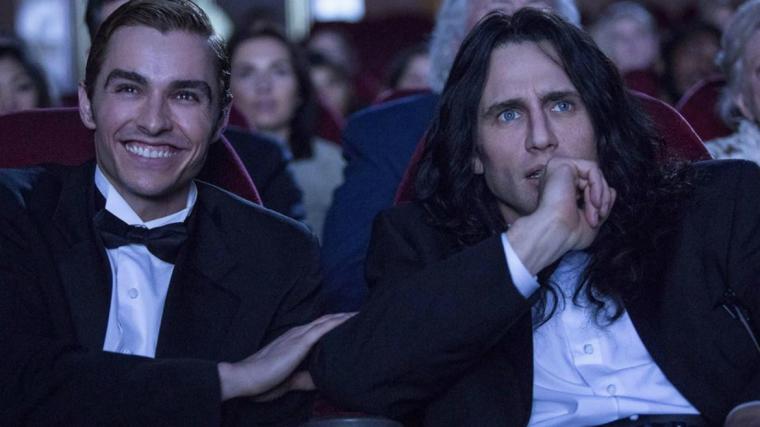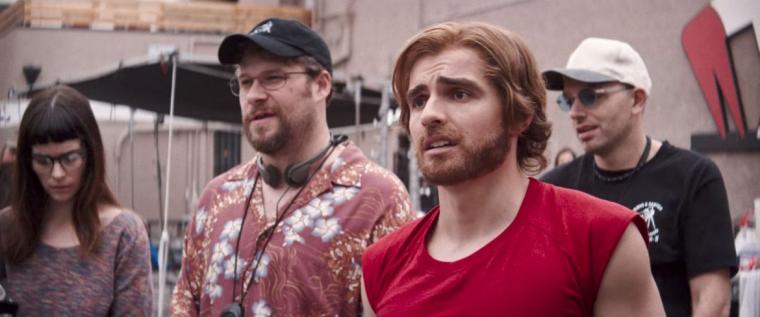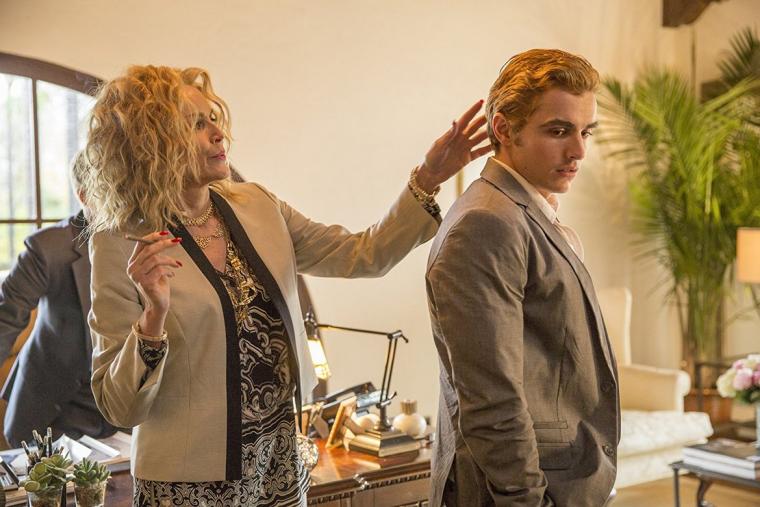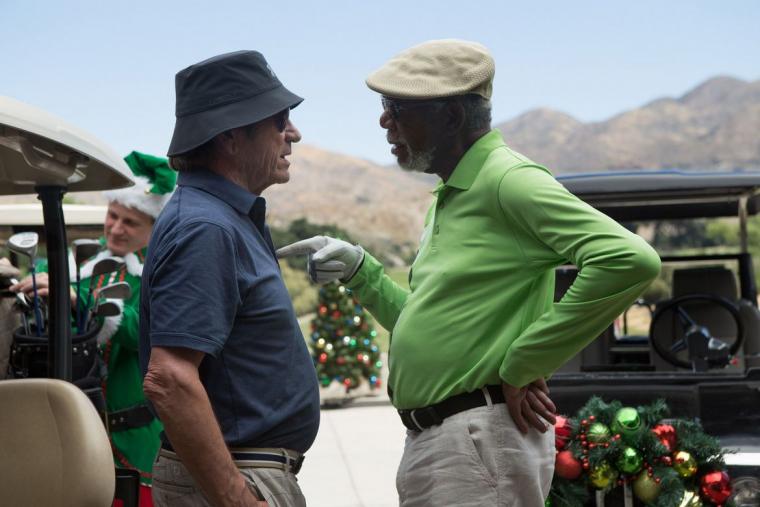
THE DISASTER ARTIST
“Hi, babe!”
That's the first sentence uttered in 2003's The Room, director/writer/producer/star Tommy Wiseau's … . Gosh, what would you call it? A failed erotic thriller? A weirdly confused amalgam of Tennessee Williams and Alfred Hitchcock? A demented art-film exploration into the dangers of lovers, friends, and everyday kitchenware substituting for wall art? Whatever it is, in Wiseau's hands, it's unparalleled cinematic beauty – the rare type of terrible movie that transcends run-of-the-mill ineptitude to become something utterly hypnotic, hugely satisfying, and ultimately unforgettable. To see The Room is to live The Room, and I'm not sure I ever fully lived until I saw The Room.
Let's be clear: Dreadful movies, as a rule, are not inherent good times. Even legendary catastrophes such as Ed Wood's Plan 9 from Outer Space aren't that much fun to sit through, because beyond the abysmal everything we're seeing and hearing, there oftentimes appears to be an enjoyment-quashing practicality behind the on-screen horrors: “Let's just wrap this scene up and move on to the next one.” (One of the many fabulous insights in Tim Burton's 1994 Ed Wood is its suggestion that thriftiness and speed were considered essential elements of art.)
The Room isn't like that. The Room is clearly made by an intensely sincere, intensely misguided wannabe auteur who really, truly believes that his San Francisco-based chamber drama is not only going to open doors, but blow the freakin' things off their hinges. Wiseau wants to be Williams and Hitchcock, but he also, God love him, wants to be Marlon Brando and James Dean. And that impossible mission, given Wiseau's clear lack of talent and sense, makes The Room not just awful but endearingly awful, even when you're aching for Wiseau to wrap a scene up and move on to the next one. I'd say that I've sat through the film more than a dozen times since I first saw it in 2009, but as true as that is, “sat through” implies a level of displeasure. Even given The Room's wretched acting and ludicrous scripting and four – four! – unwisely protracted soft-core sex scenes, in all those viewings, I've never been bored.
Which brings us back to “Hi, babe!” That's Wiseau's greeting, in his role as The Room's tragic hero Johnny, to his fiancée Lisa – a blond nightmare who will soon initiate an affair with Johnny's best friend Mark, lie about Johnny hitting her, and casually toss off her mother's admission “I definitely have breast cancer.” Whenever I introduce the movie to friends who have yet to experience it, I always preface by saying that if they don't laugh at the film's first line, we might as well stop there, because Wiseau – a man of still-unspecified foreign extraction with long, jet-black hair and Neanderthal features – is instantly amazing. You wouldn't think anyone could so colossally screw up such an easy salutation to a longtime lover, but Wiseau somehow finds a way: The energy is off, the timbre is off, the high-pitched read doesn't match his sinister look, and the strange stiltedness makes it sound like Wiseau has never before spoken a word of English.

Things only go down (or rather, way, way, way up) from there. If you immediately respond to that first, insanely incorrect line delivery – and to the whole of this bizarre, convoluted soap opera – the way sentient beings should, you're in thrall to Wiseau, his earnest yet clearly dumbfounded co-stars, his ridiculous script, and his epically noble failure that may be the worst movie of the modern era, but a movie that's by no means uninteresting or unenjoyable. What could have possibly motivated Wiseau to make such a fascinating debacle? What could the experience of making it have possibly been like? Who is this guy?!
Those are the questions raised by The Disaster Artist, director/star James Franco's adaptation of the tell-all by Greg Sestero (who played The Room's Mark) and Tom Bissell, and the heartbreak of this otherwise terrifically engaging movie is that none of them get answered in particularly satisfactory ways. Part of the problem, for me at least, is that The Disaster Artist has already been adapted into an accessible, rather exhilarating entertainment, as Sestero recorded an audiobook version of his bestseller that's like an 11-and-a-half-hour radio play, with the co-author proving remarkably adept, and hilarious, at mimicking Wiseau's oddly soothing, Eastern-European sing-song cadences. (Watching The Room and Sestero's tortuously uncomfortable performance, you'd never have imagined the guy had this kind of nimble, openhearted comedian in him.) But the bigger problem, beyond the traditional dilemma of trying to squeeze a book's contents into manageable feature-film length – with The Disaster Artist's script by the prolific duo of Scott Neustadter and Michael H. Weber – is that Wiseau remains unknowable, and Franco and company appear to respect his impenetrable quality too much to probe.
Franco, in terms of surface details, gets most everything right with his Wiseau, and seems to get a lot right beneath the surface, too. Aided by incredibly acute and subtle facial-makeup effects, the look is totally there, and so is the physique; this may be the first and only time the sight of a naked James Franco makes audiences reflectively recoil they way they would, and do, at a naked Tommy Wiseau. The voice (although not as lovingly presented as Sestero's rendition) is there, from the singularly odd word and syllable emphases to the breathy chuckle that sounds like some alien life force attempting to mime human amusement. Yet Franco also consistently hints at the buried reserves of humiliation and pain beneath Wiseau's impenetrable exterior. Tommy's braggadocio and cock-of-the-walk confidence can give way, in an instant, to melancholy and self-pity, and Franco doesn't hold back on showing Wiseau to be maddeningly egocentric, indifferent, and cruel while also never losing the innately empathetic, underdog quality that makes The Room winning despite its routinely hateful attitudes.
As marvelous as Franco's Wiseau is, though, we never really get to know him in The Disaster Artist, which is part of the movie's point, and the main cause of its frustration. While not seriously deviating from the events of Sestero's and Bissell's time-hopping chronology, the Disaster Artist film gives us a more streamlined narrative that begins – after some documentary-esque talking-head testimony from Adam Scott, Danny McBride, Kevin Smith, Keegan-Michael Key, and other real-life Room fans – with Wiseau's dubious talents first catching the eye of fellow acting-class student Sestero (James' brother Dave Franco). By the end of the film, long after The Room's filming and its leads becoming best (if frequently adversarial) friends, we're given the impression that Greg doesn't know what makes Tommy click any better than he did the day they first met.
That may be different from what we experience from the Disaster Artist book, in which Greg seems to develop enormous personal understanding of emotions, if not facts. But adaptation-wise, it's by no means a deal-breaker. We should, however, at least get some sense of why Tommy Wiseau decided to film this particular story at this particular time, and why Greg felt so beholden to Tommy's project even when he thought it was garbage, and why everyone involved – including the seemingly sharp line producer played by a rarely-better Seth Rogen – appeared to let this unholy abomination happen. Those answers, while plentifully addressed in the book, are barely hinted at in the movie. Friends have asked me whether you need to have seen The Room in order to enjoy The Disaster Artist. I'd say no, though it'd most certainly help. It'd help further if you haven't also read the book.

But movies and books, as we all know, are vastly different things. And as a movie – with this opinion coming from an unbridled champion of The Room – The Disaster Artist is a more-than-frequent hoot. In one especially significant way, it actually improves on the book, because our literary narrator Sestero never quite comes to grips with why he's so fond of the language-mangling, malapropism-spouting loon Tommy, as even his most admiring passages land with a sheen of embarrassment. The Franco brothers' natural rapport, though, melts away that reflective inhibition. Movie Greg is still obviously aghast at much of what Tommy says and does, yet even when they fight, his reactions are always tempered with wholly understandable camaraderie, gratitude, and even love. As an actor, the ever-engaging Dave Franco isn't all that interesting here, but he's an ideal scene partner and foil for the far-more-out-there James, and I came to love the casting, and the pair's relationship, more and more as the film progressed.
As for the rest of the casting, especially for Room fanatics, The Disaster Artist is simply out of this world. The majority of the film, smartly, is centered around the actual filming of Wiseau's movie, and even if viewers will have to hit the book for the most priceless behind-the-scenes recollections, the externals are all there in the character (and accompanying performer) impersonations: Ari Graynor as Lisa, Josh Hutcherson as Denny, Jacki Weaver as Claudette, Nathan Fiedler as Peter, Zac Efron as Chris-R. (It look me until the film's finale to realize it even was Efron.) Other seminal figures in Tommy's and Greg's collective world are enacted, with equal vigor, by Alison Brie, Paul Scheer, Megan Mullally, Jason Mantzoukas, Bob Odenkirk, Jerrod Carmichael, Randall Park, a barely recognizable Sharon Stone, and Melanie Griffith, who's so harshly humane in her brief role as Tommy's and Greg's acting coach that I was immediately pissed that we don't – in the film and in general – see more of her.
Best of all is the movie's climactic scene, which finds many of the film's characters convening for the official public screening of The Room – a red-carpeted affair in which some attendees are expecting disaster, some are nervously hoping for a miracle, and most are sweetly, cluelessly ignorant about what exactly is in store for them. It proves to be exactly the train-wreck we've been led to expect … and one that eventually becomes its own kind of miniature triumph, with the agog masses united in support of a work this single-minded in its pursuit of greatness that falls so unbelievably short. The audience howls. Our audience howls. Wiseau, in time, convinces himself to be in on the joke, too. And for a few moments, everyone in The Disaster Artist, and everyone watching it, is gathered together in the understanding that true passion is self-evident, no matter how off-the-rails it falls. This largely underwhelming movie can make you feel utterly fantastic, especially during the pre-end-credits sequence that shows how closely director Franco hewed to the original Room in his shots and his cast's readings. If the man ever wants to do a full-on replication à la Gus Van Sant's Psycho, I swear I'll be first in line.

JUST GETTING STARTED
As The Room has proven, bad movies can occasionally make you unaccountably happy. Far more of them, however, make you mad. Some of them make you depressed. And a scant few of them, thank God, make you wish you were anywhere other than staring at the hateful, offensive, humiliating void you're staring at on-screen. Welcome to my experience with Just Getting Started, a thunderously wretched “comedy” that casts Morgan Freeman and Tommy Lee Jones as odd-couple antagonists attempting to evade Mafia-led assassination attempts, and score with the ladies, in a Palm Springs retirement community.
Freeman and Jones have made a lot of movies (even if this is their first one together), so it's no surprise when a random stinker lands among their credits. But while the pair's first co-starring venture wasn't screened in advance for critics, which is never a good sign, this might be the first one on either Oscar-winning actor's résumés that shouldn't have been screened for anyone. And forget critics – I'm talking about family members, coach-class travelers on airline flights, and those forced to watch the thing by gunpoint, particularly if, like me, they have lingering affection for writer/director Ron Shelton's 1988 Bull Durham. (Or, I guess, White Men Can't Jump, Tin Cup, or Hollywood Homicide, none of which I'm crazy about.) Freeman and Jones do their grumpy-old-men thing, the plot does its D-grade Midnight Run thing, poor Rene Russo does her blessedly Rene Russo thing, and nothing that happens makes a lick of emotional or narrative sense or features anything even close to a surprise. (And I could barely stand the insulting degradation of co-star Glenne Headly, who, after her unfortunate passing in June, deserved a far better screen epitaph.) It'll likely be gone, or at least on life-support, by the time the new Star Wars lands in a few days, but I still wanted to eff-ing die watching this thing. The only reason I refused to was knowing my obituary would inevitably read: “He passed away silently watching Just Getting Started.”










